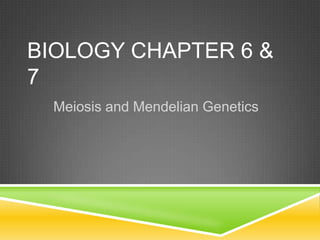
Biology chapter 6 & 7
- 1. BIOLOGY CHAPTER 6 & 7 Meiosis and Mendelian Genetics
- 2. 6.1 & 6.2 CHROMOSOMES AND MEIOSIS 6.6 MEIOSIS AND GENETIC VARIATION Mitosis Somatic cells undergo mitosis One diploid cell produces 2 genetically identical, diploid cells There are 4 stages (prophase, metaphase, anaphase, telophase) DNA is copied once and divided once Mitosis is used for development, growth, and repair
- 3. Meiosis Germ cells produce gametes (sex cells) during meiosis One diploid cell produces 4 genetically different haploid cells There are 8 stages (prophase I, metaphase I, anaphase I, telophase I, prophase II, metaphase II, anaphase II, telophase II) DNA is copied once and divided twice
- 4. Homologous Chromosomes Half of an organism’s chromosomes come from the mother, and half from the father. The chromosomes pair up to form homologous chromosomes Homologous chromosomes are two chromosomes with the same length, general appearance, and the same type of genes The pairing of the genes on the homologous chromosomes are what code for all of an organism’s traits (see examples in section 6.4)
- 5. All humans have 23 total pairs of chromosomes, for a total of 46 chromosomes. 22 of the pairs are autosomes (body chromosomes) 1 pair is the sex chromosomes (XX= female, XY=male)
- 6. Meiosis I Same steps as mitosis, except during Prophase I crossing over can occur(see below), during Metaphase I homologous chromosomes pair up in the middle and during Anaphase I, the sister chromatids DO NOT separate By the end of Meiosis I, there are 2 haploid cells
- 7. Crossing Over Homologous chromosomes exchange genes This results in a new combination of genes (called recombination) Genes that are located near each other on a chromosome are more likely to be moved (or crossed over) together. This is called genetic linkage (refer to page 191) Meiosis II This is exactly the same as mitosis
- 8. 6.3 MENDEL AND HEREDITY Gregor Mendel An Austrian monk who is known as the “father of genetics” He discovered that traits (genes) are inherited from parents by working with pea plants He made both purebred plants and crossed plants to see what the results would be.
- 9. WHY PEA PLANTS? They reproduce quickly They can both self-pollinate(creating purebreds) and cross-pollinate(creating a mix of traits) They have “either-or” traits (the traits do not mix to make a 3rd trait, ex. The purple flowers and white flowers don’t mix to make a pink flower) (refer to page 179 to see the traits and results of Mendel’s experiment)
- 10. MENDEL’S CONCLUSIONS Mendel’s Law of Segregation: Organisms inherit two copies of each gene, one from each parent Organisms donate only one copy of each gene in their gametes. Thus, the two copies of each gene segregate, or separate, during gamete formation (Law of Independent Assortment) In other words, the Law of Ind. Assortment is saying that traits are inherited separately.
- 11. 6.4 TRAITS, GENES, AND ALLELES 6.5 TRAITS AND PROBABILITIES Genes Each gene has a specific locus, or place on the chromosome A gene is a piece of DNA that provides a set of instructions to make a certain protein. The proteins then code for traits. Each trait is represented by alleles.
- 12. Letters are used to represent different alleles. There are two alleles per trait (one from mother, one from father) Dominant alleles are represented by capital letters and Recessive alleles are represented by lowercase letters Dominant alleles will always overpower the recessive alleles.
- 13. EXAMPLE: P= purple flowers p= white flowers PP=purple flowers (homozygous) pp= white flowers (homozygous) Pp= purple flowers (heterozygous) Genotype-the alleles/genetic code (PP or Pp) Phenotype-the physical trait (purple or white)
- 14. PUNNET SQUARES Punnet squares are used to predict the outcome of genotypes when crossing two organisms Monohybrid cross- crosses one trait (always yields a 3:1 phenotypic ratio) Dihybrid cross- crosses two traits (always yield 9:3:3:1 phenotypic ratio)
- 15. CHAPTER 7 EXTENDING MENDELIAN GENETICS Complex Patterns of Inheritance Incomplete Dominance—the trait is in between the dominant and recessive Ex. RR=red rr=white Rr=pink Codominance—both traits are expressed at the same time Ex. RR=red rr=white Rr= both red and white
- 16. Polygenic Traits—when two or more genes influence a trait Ex. Human eye color(at least 3 different genes), human skin color (4 different genes) Environmental factors—when the environment plays a role in gene expression Ex. Sea turtle eggs become female in warmer temps and male in colder temps
- 17. SEX-LINKED TRAITS—TRAITS CAUSED BY GENES LOCATED ON THE SEX CHROMOSOMES The X contains many genes The Y only determines sex (male) A male is XY, so all of the alleles on the X are expressed in a male, even the recessive ones A female is XX, so dominant alleles can mask the recessive ones Carriers—those who carry a recessive genetic disorder, but do not express the phenotype. They can pass on the disorder to their offspring